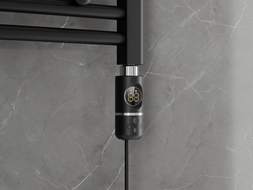
When planning a bathroom renovation or constructing a new shower stall, one of the key aspects to consider is the slope under the shower. While it may seem like a minor detail, the proper floor incline is crucial for the comfort and functionality of the shower. An improper slope can lead to drainage problems, increasing the risk of slipping.
In the following entry, we will examine what slope under the shower is optimal to ensure effective water drainage and user comfort.
What should be the slope under the shower?
The appropriate water drainage rate requires a slope to the linear drain of about 1 - 2%, which corresponds to an incline ranging from 0.6 - 1.2 degrees.
How to calculate the slope?
- A 1% slope means a drop of 1 cm per meter of length, which corresponds to about 0.57 degrees.
- A 2% slope means a drop of 2 cm per meter of length, which corresponds to about 1.15 degrees.
In some water drainage systems, it is worth applying a larger slope oscillating around 2.5%. This guarantees optimal capacity and effective water drainage without the risk of creating wet spots both under the shower and outside the stall.
Slope under the shower with a linear drain
It is worth emphasizing that the appropriate slope under the shower must be taken into account when using a linear drain - usually employed in walk-in stalls, which, unlike shower trays, do not have a threshold. If you have a shower stall with a tray, the slope is not as significant.
So, what is a linear drain? It is a plumbing fixture integrated with the vertical sewage system. Its main task is to drain water during shower use. It consists of a long panel (channel), made of high-quality materials (stainless steel or plastics), that cover the drainage channel.
Linear drains are mounted in the shower floor, allowing for a seamless floor surface without the need for traditional trays. Their design enables minimal slope towards the drain, promoting quick and effective water drainage. This minimizes the risk of flooding the bathroom and ensures a high level of hygiene.
Thanks to their minimalist and elegant form, linear drains are characterized by high aesthetic value and functionality.
What linear drain to install in your bathroom?
Choosing the right linear drain for the bathroom and individual needs is crucial. It impacts both the functionality and aesthetics of the entire bathroom.
Here are some tips that will help in selecting the right linear drain.
1. Determine the installation location
Decide where to install the linear drain:
- by the wall - ideal if you want to hide the drain and achieve a seamless floor surface;
- in the center of the shower - often used in larger stalls where water flows from various directions.
2. Choose the appropriate length
Linear drains are available in various sizes - typically their length ranges from 30 cm to 120 cm.
The length of the drain should match the size of the shower:
- shorter drains are sufficient for smaller stalls;
- longer drains may be necessary in larger shower stalls to ensure effective water drainage.
3. Material and appearance
Linear drains can be made from various materials, such as stainless steel, plastic, or brass. Choose a material that matches your bathroom's style and provides durability. Stainless steel is the most popular choice due to its corrosion resistance and elegant appearance.
4. Capacity
Check the capacity of the drain, which is the amount of water the drain can handle in a specific time period.
5. Cleaning system
Choose a drain that provides easy access to the cleaning system. Some models have removable grates or special baskets that facilitate the removal of debris.
6. Installation height
Pay attention to the height of the drain and the possibility of installing it in the floor. Some drains require greater depth, which can be problematic in the case of thin floors.
7. Price and quality
Compare different models in terms of price and quality. Cheaper options may be tempting, but investing in a higher quality drain can yield benefits in the long run, ensuring durability and reliability for many years.
What slope under the shower with a linear drain is optimal? Summary
The choice of the appropriate slope under the shower affects the comfort and functionality of the entire bathroom. The optimal floor incline, around 2% (1.2 degrees), ensures effective water drainage. This minimizes the risk of wet spots and increases user safety.
It is also important to consider aesthetics and hygiene – the correct slope prevents water from pooling, which helps maintain cleanliness and prevents the growth of mold and mildew on the grout and tiles. By ensuring the proper slope, you are investing in the functionality and durability of your bathroom, bringing benefits for many years.



















